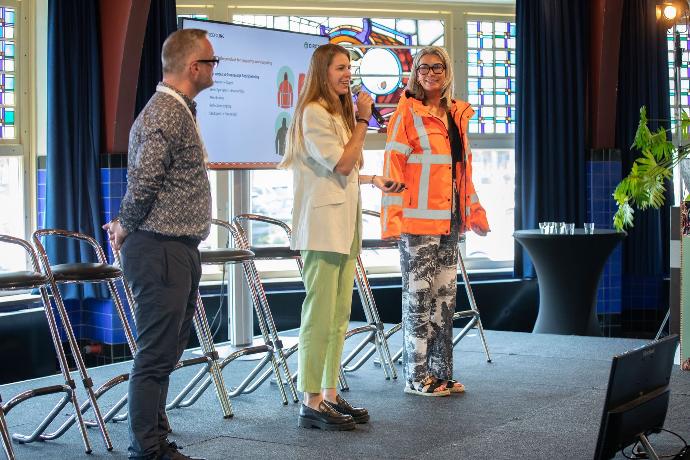Textiles are part of our daily lives, providing us with clothing, shoes, carpets, curtains, furniture, etc. for homes, offices, and public buildings. The textile industry is one of the largest manufacturing industries in the world but also one of the most polluting. In the EU, clothing, footwear, and household textiles represent the fourth highest category for the use of primary raw materials and water; after food, housing, and transport[1].
Reducing the environmental and climate impacts from textile production and consumption, while maintaining economic and social benefits, requires a systemic change towards circularity. However, achieving circularity in the industry still has a long way to go. Recycled fabric, especially recycled polyester, mainly comes from plastic water bottles recycling. Actual fabric is rarely recycled and often ends up as waste; it has been estimated that 4.3 million tonnes of textiles are sent to incineration or landfill every year in the EU[2]. The reasons for this are manyfold. On the one hand, polyester is often mixed with other materials, such as cotton or elastane. On the other hand, recycling requires clothing to be disassembled – a process that is time, energy, and money consuming.
The Interreg NWE CircTex project ‘Innovation towards a circular future for NWE textiles’ has been working on transforming textile waste into a circular investment. The project set up an international standard for circular textiles and implemented, tested, and approved the first 100% circular workwear collection.
Nine organisations from North-West Europe and Spain have joined forces to develop a clothing collection that has been designed from and for recycling, ensuring that nothing goes to waste. The clothing was produced using 100% polyester fabric and assembled with the Wear2® thread. Developed by the project partner Wear2Go, this thread has a similar look and feel to other threads on the market but is unique due to its innovative core material that loses its strength under the influence of electromagnetic energy. This enables garments sewn with this thread to be taken apart in under 60 seconds in a tunnel disassembler, making textile reuse, remanufacturing, and recycling possible.
The CircTex project focused on the development of recycling and production technologies in a closed-loop process chain for PET[3] workwear. Workwear is the ideal starting point for an industry-wide transformation since the sector has a high need of materials as reuse is not allowed. CircTex partners have worked closely together to demonstrate not only that producing a jacket designed for recycling is possible, but also that this same jacket, after being worn, can be transformed into a new jacket, fully closing the circle. Wear tests, involving 150 employees from various organisations were performed for the newly produced items, to ensure that user comfort and quality were not compromised.
The CircTex project also laid groundwork for the current development of European regulations as part of the EU strategy for sustainable and circular textiles. Among the actions laid out in the strategy, one of the goals is to encourage companies to be transparent and introduce clearer information about the origin of their products. The so-called ‘Digital Product Passport’ must provide insight into where a piece of clothing comes from. In the framework of the CircTex project, a digital passport was set up to give end-to-end information about the jacket journey, from the raw materials used to the final product, as well as information about how it should be treated when it reaches its end-of-life.
In order to bring about change towards circularity across the entire system, education and behavioural change are also important. The growing demand for sustainability in textiles is a result not only of consumer concerns for transparency and environmentally friendly and high-quality products, but also of pressure throughout the supply chain to meet these expectations. The Circular Textile Days were initiated by CircTex to bring these stakeholders together, stimulate collaboration and enhance the awareness of sustainable developments and opportunities. Although CircTex is coming to an end, CircTex partners will carry on working together and are planning the fourth edition of the Circular Textile Days in 2024.
One of the key takeaways from the project is that circularity in textile needs cooperation. The successful implementation of the project lies in the complementarity of its partners, gathering industry players (Wear2Go, Texowear, C-Tech Innovation Limited, J&A, Antex, Global Technical Fabrics), suppliers (Groenendijk workwear), R&D and innovation centres (EuraMaterials, Centexbel), and business associations (MODINT).
Not only did the project explore the production of circular garments, but it also addressed the entire ecosystem by developing a protocol for circular workwear that can be used by the textile industry as a whole. The future of circular textiles looks bright and CircTex is leading the way!
Key facts and figures
- 9 partners
- 5 countries: BE, NL, FR, UK, ES
- 4 years of common work: 2019-2023
- Budget: € 4 m
More information
CircTex website Circular Textile Days CircTex 100% workwear video
[1] European Commission, Directorate-General for Environment, Sustainable and circular textiles by 2030 –, Publications Office of the European Union, 2022, https://data.europa.eu/doi/10.2779/122408
[2] Friends of the Earth Europe, Less is more: resource efficiency through waste collection, recycling and reuse, 2020, https://friendsoftheearth.eu/publication/less-is-more-resource-efficiency-through-waste-collection-recycling-and-reuse/
[3] Polyethylene
terephthalate (PET) is the most common thermoplastic polymer resin of the
polyester family.

